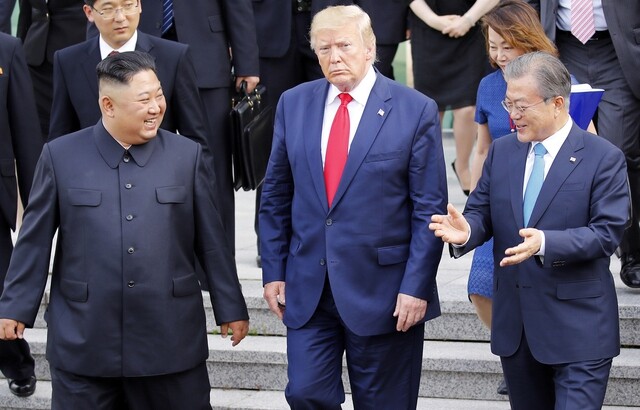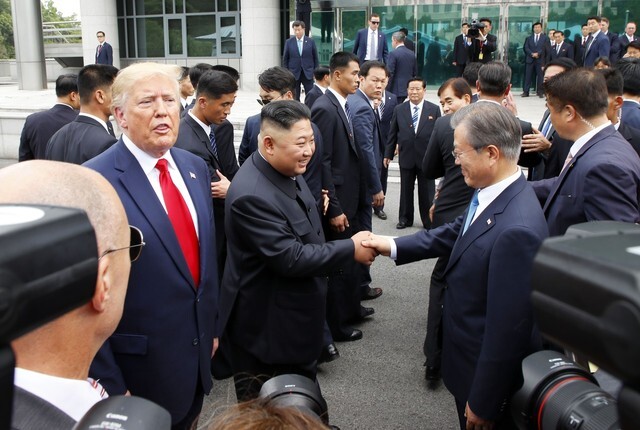hankyoreh
Links to other country sites 다른 나라 사이트 링크
[Editorial] Kim, Trump, and Moon’s Panmunjom meeting critical to dismantling Cold War Regime

On June 30, with the world looking on, the leaders of South Korea, North Korea, and the US met at Panmunjom, a symbol of the Cold War and the continuing division of the Korean Peninsula. With the support of South Korean President Moon Jae-in, US President Donald Trump and North Korean leader Kim Jong-un gave each other a firm handshake at the Military Demarcation Line (MDL) at Panmunjom. Echoing the events of the inter-Korean summit on Apr. 27, 2018, Trump crossed over to the North Korean side of Panmunjom and then returned to South Korean territory with Kim. In doing so, Trump became the first US president to step foot in North Korea. It was a truly historic scene.
The first remark was made by Kim Jong-un, who called for reckoning with the past and moving forward into the future, while Trump said he was “proud” to have crossed the MDL at Panmunjom. Kim and Trump then held what was effectively their third summit at the House of Freedom, a meaningful incident that transformed Panmunjom from a symbol of division into a symbol of peace. The meeting of these three leaders and the third North Korea-US summit represented a series of unexpected, and indeed unprecedented, events.
The convergence of these three leaders at a single place was a historic meeting on a different level from an inter-Korean summit or a North Korea-US summit. It can be seen as the result of Moon’s proactive and indefatigable role as facilitator, as the South Korean president is determined to sit in the driver’s seat on Korean Peninsula issues. It was also a global happening brought into being by Kim and Trump’s commitment to the denuclearization of the Korean Peninsula and the establishment of a peace regime there. The meeting in Panmunjom by the leaders of the three countries that are parties to war and division will go down as the turning point that effectively spells the end of the armistice regime on the Korean Peninsula that has lasted for 66 years. It’s our fervent hope that their meeting will be a major step toward the complete denuclearization of the Korean Peninsula, the establishment of peace there, and a radical improvement of North Korea-US relations.
Just three or four days ago, the rendezvous among the three leaders would have been almost unimaginable. While the inter-Korean summits and North Korea-US summits that have been held since spring of last year have been a series of surprises, this meeting at Panmunjom can be seen as the ultimate shock. The proposal tweeted by Trump at an hour when nobody expected it and the swift response from North Korea that came just five hours later represent a massive and irreversible milestone on the journey toward the dismantlement of the Cold War regime on the Korean Peninsula.
This groundbreaking meeting would’ve been hard to pull off if not for closed-door negotiations among the three countries. It’s natural to assume that the personal letters exchanged by Kim and Trump served as the springboard for this meeting. To be sure, Kim claimed that he’d known nothing about Trump’s proposal in advance. But if there hadn’t been off-the-record interaction, such an abrupt meeting likely wouldn’t have occurred. The historic meeting in Panmunjom can be regarded as the fruition of efforts by all three parties to revive the denuclearization talks and to restart suspended dialogue.

Significance of de facto 3rd summit in Panmunjom
What’s just as significant as the simultaneous meeting of these three leaders is that Kim and Trump held what was effectively their third summit at the historic location of Panmunjom. The two of them set aside the resentment produced by the collapse of dialogue in their second summit in Hanoi this past February and created a dramatic turning point. After the meeting, Trump said that working-level officials would be meeting with the North Koreans for a few weeks for technical negotiations aimed at producing an all-encompassing agreement. During their meeting, Kim and Trump apparently confirmed the major points of disagreement and sketched the outline of a future agreement.
This brief meeting was significant in the sense that it ended the protracted impasse and paved the way toward a new beginning. The meeting that had been expected to last for a couple of minutes turned out to be a nearly hour-long tête-à-tête, which itself offers bright prospects for negotiations moving forward. Kim may not have responded immediately to Trump’s invitation to visit the White House, but that very invitation can only be taken as an indication of rapid progress in North Korea-US relations.

Top-down method remains the primary approach to North Korea-US dialogue
The Panmunjom meeting can be seen as demonstrating that the top-down method remains a valid approach — indeed, the only approach — in North Korea-US dialogue. The meeting of the three leaders can further be seen as bolstering Kim’s position, which was undermined by the Hanoi debacle. By faithfully playing his role as facilitator of North Korea-US relations, Moon also enhanced his status as “driver” of Korean Peninsula issues. This meeting increases the likelihood that the Korean Peninsula peace process will move forward more rapidly than ever before.
While this meeting was a major breakthrough in the North Korea-US denuclearization talks, the two sides have yet to get to the heart of the issue. This needs to be followed by actual denuclearization and progress in North Korea-US relations. Earlier, Stephen Biegun, the US State Department’s special representative for North Korea, stressed the need for a flexible approach in negotiations with North Korea and expressed his willingness to deal with all matters simultaneously and in parallel, harking back to the spirit of the Singapore agreement. This can be seeing as overlapping to some extent with the “synchronous and phased” solution that North Korea has called for. Our hope is that the two sides will make definite progress on this issue in their upcoming working-level talks. Since North Korea has asserted that a security guarantee for the regime and rewards for denuclearization are some of its major interests, North Korea and the US need to reach a meaningful agreement on that.
Kim, Moon, and Trump’s meeting at Panmunjom and the North Korea-US summit held there will be remembered as a crucial episode leading to the dismantlement of the Cold War system and the armistice regime on the Korean Peninsula. It goes without saying that the episode can only create momentum toward bringing peace to the Korean Peninsula if it leads to follow-up measures that are commensurate to its historic significance. North Korea and the US must engage in proactive and assertive negotiations in order to heal the trauma from the breakdown of talks in Hanoi this past February and to write a new chapter in the history of their bilateral relations. We earnestly hope that the meeting of the three leaders in Panmunjom, the meeting that shocked the world, will lead to swift progress toward permanently dismantling the Cold War system on the Korean Peninsula, establishing a complete peace regime there, and achieving swift progress on the denuclearization talks and on resetting North Korea-US relations.
Please direct comments or questions to [english@hani.co.kr]

Editorial・opinion
![[Editorial] Does Yoon think the Korean public is wrong? [Editorial] Does Yoon think the Korean public is wrong?](https://flexible.img.hani.co.kr/flexible/normal/500/300/imgdb/original/2024/0417/8517133419684774.jpg) [Editorial] Does Yoon think the Korean public is wrong?
[Editorial] Does Yoon think the Korean public is wrong?![[Editorial] As it bolsters its alliance with US, Japan must be accountable for past [Editorial] As it bolsters its alliance with US, Japan must be accountable for past](https://flexible.img.hani.co.kr/flexible/normal/500/300/imgdb/original/2024/0417/6817133413968321.jpg) [Editorial] As it bolsters its alliance with US, Japan must be accountable for past
[Editorial] As it bolsters its alliance with US, Japan must be accountable for past- [Guest essay] Amending the Constitution is Yoon’s key to leaving office in public’s good graces
- [Editorial] 10 years on, lessons of Sewol tragedy must never be forgotten
- [Column] A death blow to Korea’s prosecutor politics
- [Correspondent’s column] The US and the end of Japanese pacifism
- [Guest essay] How Korea turned its trainee doctors into monsters
- [Guest essay] As someone who helped forge Seoul-Moscow ties, their status today troubles me
- [Editorial] Koreans sent a loud and clear message to Yoon
- [Column] In Korea’s midterm elections, it’s time for accountability
Most viewed articles
- 1Samsung barricades office as unionized workers strike for better conditions
- 2[Column] The clock is ticking for Korea’s first lady
- 3[Editorial] When the choice is kids or career, Korea will never overcome birth rate woes
- 4Why Israel isn’t hitting Iran with immediate retaliation
- 5[News analysis] After elections, prosecutorial reform will likely make legislative agenda
- 6S. Korea, Japan reaffirm commitment to strengthening trilateral ties with US
- 7Japan officially says compensation of Korean forced laborers isn’t its responsibility
- 8[Editorial] As it bolsters its alliance with US, Japan must be accountable for past
- 9[Editorial] Does Yoon think the Korean public is wrong?
- 10[Guest essay] How Korea turned its trainee doctors into monsters